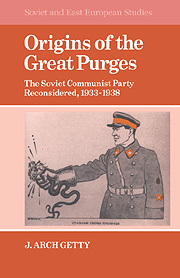Book contents
- Frontmatter
- Contents
- List of tables
- Preface
- Introduction: the Great Purges as history
- 1 The Communist Party in the thirties
- 2 What was a purge?
- 3 The Verification of Party Documents of 1935: a case study in bureaucratic ineptitude
- 4 Radicalism and party revival
- 5 Radicalism and enemies of the people
- 6 The crisis matures: 1937
- 7 Epilogue: the Ezhovshchina
- Conclusion: some observations on politics in the thirties
- Appendix: the Kirov assassination
- Bibliographic essay
- Notes
- Index
- SOVIET AND EAST EUROPEAN STUDIES
Conclusion: some observations on politics in the thirties
Published online by Cambridge University Press: 23 September 2009
- Frontmatter
- Contents
- List of tables
- Preface
- Introduction: the Great Purges as history
- 1 The Communist Party in the thirties
- 2 What was a purge?
- 3 The Verification of Party Documents of 1935: a case study in bureaucratic ineptitude
- 4 Radicalism and party revival
- 5 Radicalism and enemies of the people
- 6 The crisis matures: 1937
- 7 Epilogue: the Ezhovshchina
- Conclusion: some observations on politics in the thirties
- Appendix: the Kirov assassination
- Bibliographic essay
- Notes
- Index
- SOVIET AND EAST EUROPEAN STUDIES
Summary
We see, therefore, at first the picture as a whole, with its individual parts still more or less kept in the background; we observe the movements, transitions, connections rather than the things that move, combine, and are connected.
Friedrich EngelsOne should hope that the anonymous NKVD official was lying to Isaak Babel's widow when he told her that the police had burned much of their archive as the Germans approached Moscow in 1941. Until and unless such sources become available, it is impossible for a study of the Great Purges period to be definitive, and it is dangerous to venture many firm conclusions about the politics of the 1930s. Yet the press, Smolensk Archive, and other printed sources do make it possible to see the outlines of politics in the Communist Party in the period and to make some observations, suggestions, and hypotheses. This effort may well have raised as many questions as it answered, but because of the need to reexamine and rethink the Stalin period, new questions should not be out of order.
This analysis has concentrated on the center–periphery conflict within the party apparatus. This struggle is important to the political history of the thirties; and it was a substantial part of the background of the Great Purges. In addition to the material presented above, a look at Central Committee membership in the thirties highlights the importance of this tension. Indeed, the trend of representation of regional party officials in the Central Committee illustrates the rise and fall of the territorial secretaries in this decade.
- Type
- Chapter
- Information
- Origins of the Great PurgesThe Soviet Communist Party Reconsidered, 1933–1938, pp. 196 - 206Publisher: Cambridge University PressPrint publication year: 1985



